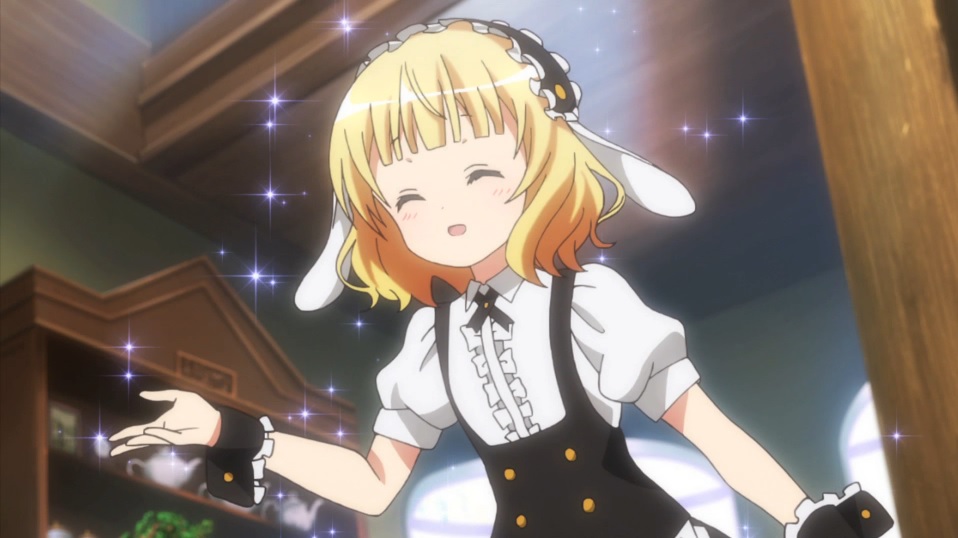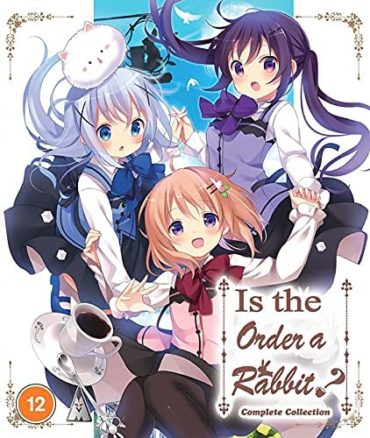Is the Order a Rabbit? Season 1 Review
WARNING: This series is unsuitable for residents of the Isle of Portland, Dorset, where rabbits are considered such bad luck due to the belief their burrowing caused landslides in local quarries that it is taboo to even say the word “rabbit”, let alone see one. Admittedly however, if you have read beyond the title, chances are this warning doesn’t bother you and is just a way to insert some unrelated trivia into this article.
While Is the Order a Rabbit? may be described as a slice-of-life series, there is plenty of stuff in this comedy that is not what you normally expect to find in your day-to-day goings on.
It begins with a girl named Cocoa Hoto, a student who has moved to a town in Japan that is built in a European style. She gets lost on the way to her accommodation, so stops off at a café, Rabbit House, partly to get her bearings but mainly in the hope of cuddling some rabbits. However, the café only has one bunny in it: Tippy, a very fluffy angora rabbit who normally sits upon the head of Chino Kafu, granddaughter of Rabbit House’s owner, who works there as a waitress.
It turns out that this is actually the place Cocoa is meant to be staying, with Cocoa not just boarding there while she attends the local school, but also doing chores around the place too. She quickly gets a job as a waitress in Rabbit House, despite not being able to tell different coffees apart by taste. Cocoa and Chino are not the only people working there: there is also Rize Tedeza, another student working part-time at Rabbit House. Rize comes from a wealthy military family, and as a result she is obsessed with anything to do with the military, including carrying model guns on her person. Even when she makes latte art drawings in the coffee she serves, she draws tanks and fighter planes in the customers’ drinks. Meanwhile, Chino’s father, Takahiro, runs Rabbit House at night, when it becomes a bar.

Cocoa also makes friends with other people around town. One of her classmates, Chiya Ujimatsu, is a waitress at rival Japanese-style coffee shop called Ama Usa An, where she serves confectionary which she gives odd names to. Living next door to Chiya is Syaro Kirima, a classmate of Rize’s and who works as a waitress at Fleur de Lapin, a café specialising in herbal tea. Syaro is also scared of rabbits, doesn’t like others knowing how poor she is, and acts drunk when she consumes too much caffeine.
The series follows all five girls as they make their way through life, enjoying each other’s company and improving their lives. Along the way, the girls embrace Cocoa’s love of baking, make friends with a local novelist who works under the name Aoyama Blue Mountain, as well as Chino’s classmates Maya and Megu who occasionally help out in Rabbit House, and spend many hours having fun together. There is also the otherworldly issue regarding Tippy: when Cocoa first meets him and Chino, she thinks Tippy speaks by Chino is using ventriloquism. As the story progresses, it appears Tippy is the reincarnation of Chino’s dead grandfather – something that Cocoa may have got involved in when she was younger.
The best feature of Is the Order a Rabbit? is the comedy. Each of the central characters has their own style of humour to bring to the series. Cocoa is silly and obsessed with hugging just about anything fluffy, with an added little-sister complex meaning that she wants younger girls to like her. This balances well with Chino who, despite being the youngest of the characters, is actually the most mature of the gang, acting as a kind of straight woman. Rize is my personal favourite, her love of all things military adding a bit of the surreal to this generally cute and cozy show. Chiya’s habit of giving odd names to her dishes gives her some laughs, as well as the fact that she is physically weak and gets tired out whenever there is anything physical that needs doing. Syaro’s many odd behaviour traits, including her rabbit phobia, poverty and her reaction to caffeine, make her entertaining too.

As mentioned, the character of Tippy does add a bit of fantasy to the story with the idea that he is the reincarnation of Chino’s grandfather. This is not the only oddity in the series, the other one being the fact that these girls drinks a heck of a lot of coffee, but generally have none of the caffeine-related problems you’d normally expect to see when you drink a lot of stuff, and I don’t mean Syaro’s drunken moments. There are scenes at night where you see Chino in her pyjamas, implying it is getting close to bedtime, where she is still drinking coffee. At no point do you see any of these girls acting all wired on the stuff.
Aside from the comedy, the other main appeal of the series is the artwork. The backgrounds and landscapes for the series are particularly good, the drawings of the European-style buildings adding to an overall kawaii feeling for the series. While much of it is based on a French style, with supermarkets in the town being called “supermarché”, there are other styles too, with Ama Usa An being depicted in a more traditional Japanese style.

When it comes down to the release, MVM’s collection of this first series is very limited. In this one-disc Blu-ray collection, there is only a Japanese-language dub available, while the only extras are textless opening and closing. The songs used are performed by the cast themselves. The opening, “Daydream Cafe”, is performed by the “Petit Rabbit’s”, who are the five main voice actors in the show. The ending, “Poppin’ Jump♪”, is performed by Chimame-tai, which consists of the actors for Chino, Maya and Megu, and is personally my favourite of the two.
Is the Order a Rabbit? is a fun series with many laughs and cute art to credit to its name. There is also more to look forward to, as a further two series of the show have been made. I’m happy to be a return customer.


